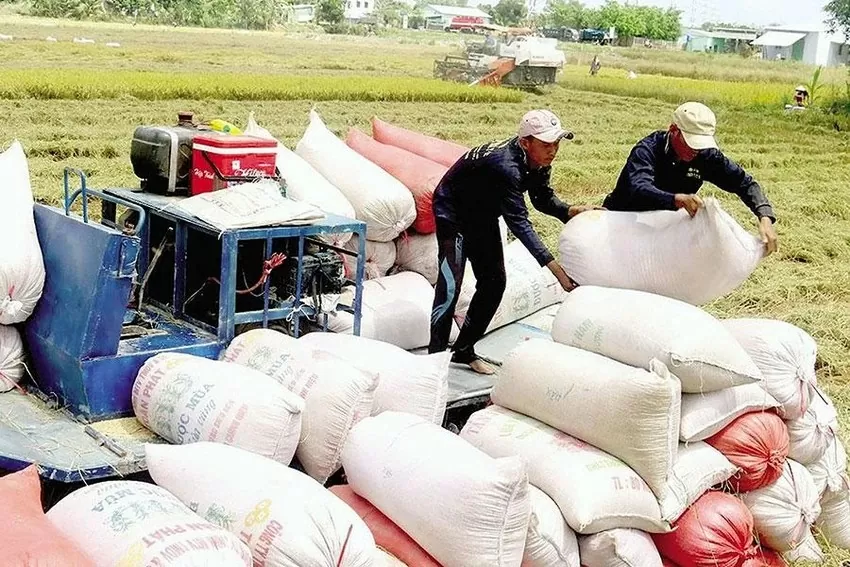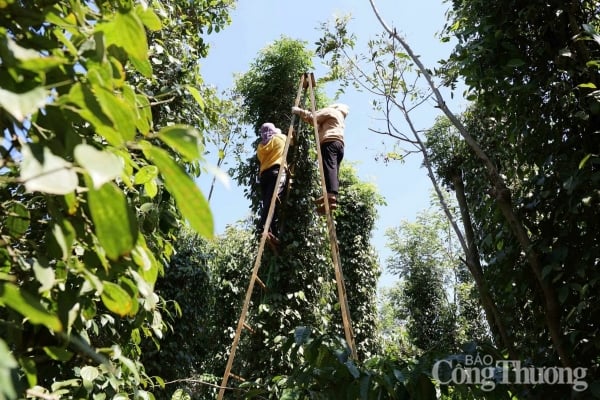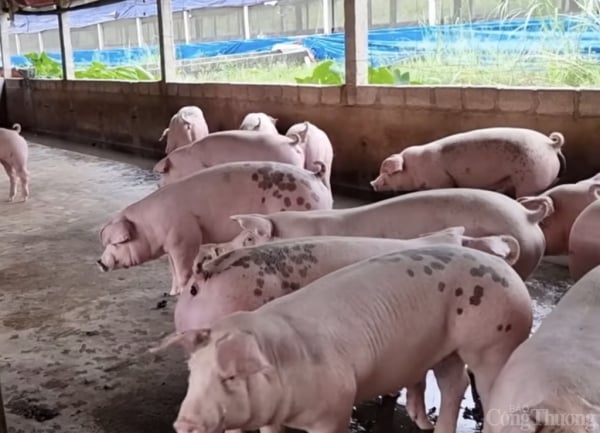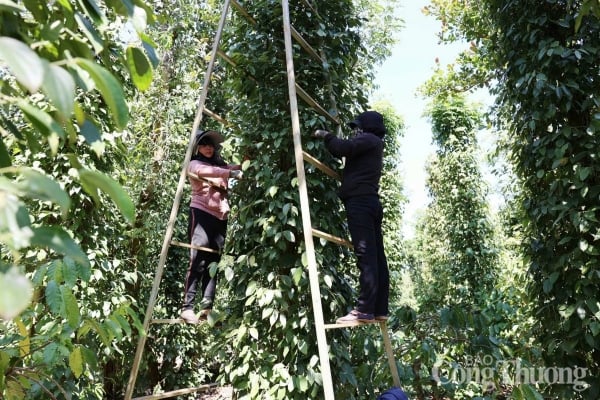Usually, it takes 2 months for domestic rice prices to fall following the market trend. This is the reason why rice prices are cheap, export rice prices decrease, but domestic rice prices remain high.
Rice prices are 40-50% lower than last year.
According to the Vietnam Food Association, currently, each kilogram of regular rice in the field costs an average of VND5,400, while fragrant rice costs VND7,000-8,500. In the warehouse, the price of fragrant rice has dropped to VND8,000-9,500 per kilogram, 40-50% lower than last year.
 |
| Vietnam is one of the three largest rice exporting countries in the world. Photo: Quang Huy |
In the export market, according to updated data from the Vietnam Food Association on February 17, Vietnam's rice export prices are still maintained at below 400 USD/ton. Specifically, 5% broken rice is being offered for sale at 395 USD/ton; 25% broken rice is being offered for sale at 372 USD/ton; 100% broken rice is being offered for sale at 310 USD/ton.
Meanwhile, Thai rice exports are at better prices. Specifically, 5% broken rice is being offered at $418 per ton; 25% broken rice is being offered at $397 per ton; and 100% broken rice is being offered at $365 per ton.
Similarly, India's 5% broken rice export price is at 413 USD/ton; 25% broken rice is at 394 USD/ton. Meanwhile, Pakistan's 5% broken rice export price is at 402 USD/ton; 25% broken rice is at 370 USD/ton; 100% broken rice is at 337 USD/ton.
Thus, in general, Vietnam's rice exports are the lowest among the top four exporters, including India, Thailand and Pakistan. Last year, Vietnam benefited when India restricted exports, causing rice prices to rise and exports to reach a record 9 million tons. However, when the country lifted the ban, the market reversed quickly. Global supply increased sharply, causing prices to fall.
At the same time, Indonesia - Vietnam's second largest market - is promoting food self-sufficiency, importing only a small amount. The Philippines is also limiting purchases due to abundant inventories. According to the General Department of Customs, rice exports to Indonesia in January reached only 651 tons, down 98% compared to the same period last year, causing domestic prices to plummet.
Mr. Nguyen Vinh Trong - Sales Director of Viet Hung Company Limited (Tien Giang) - informed that the export price of rice has decreased sharply because the export market is not yet bustling, the Philippines is buying in small amounts, and Indonesia is limiting imports. Meanwhile, it is currently the peak harvest season of the Winter-Spring crop, so export enterprises have not yet increased rice imports into warehouses. They are waiting to hear about market prices.
The sharp drop in export rice prices has also caused strange phenomena in Vietnam’s rice export granary – the Mekong Delta. Accordingly, since the beginning of the year, some traders in Dong Thap, Ben Tre, Tien Giang, etc. have used trucks to transport rice and advertised it for sale at cheap prices along rural roads.
The price of each kilogram of rice sold by small traders is commonly 12,000-15,000 VND, 4,000-8,000 VND/kg lower than the price at the markets (depending on the type), so many people in the area have rushed to buy and stockpile.
According to traders, this rice was milled by traders from rice purchased from farmers before Tet. Normally, milled rice is stored by traders at the factory, waiting for businesses to buy. This year, prices have dropped sharply, businesses are buying in small amounts, so they decided to sell it on the street because they are worried that if they keep it in the warehouse and the price drops further, they will lose more money.
According to a trader in Ben Tre, the average price of 50kg bags of rice is being offered at 600,000 - 750,000 VND, or 12,000 - 15,000 VND per kg, 20 - 40% lower than the market price. The means of transportation used by traders is trucks. Usually, traders will choose a local location and sell for about a week, after the purchasing power gradually decreases, they will move to another place to sell.
Domestic rice prices lag behind export markets
In Ho Chi Minh City, the price of blooming rice remains at 17,000 VND/kg, American fragrant rice at 19,000 VND/kg, and Nang Hoa rice at 23,000 - 24,000 VND/kg, almost unchanged from last year's peak. In Hanoi, the price of Japanese jasmine rice is at 22,000 VND/kg, Dien Bien jasmine rice at 19,000 VND/kg, and Thai jasmine rice at 20,000 VND/kg;... According to experts, the "street selling" of rice by traders is an opportunity for people to access cheap rice, while retail prices on the market remain high.
Cheap rice prices, reduced export rice prices, but still high market rice prices? Talking to reporters of the Industry and Trade Newspaper, agricultural expert Hoang Trong Thuy said that although rice exports have decreased, domestic rice prices have not decreased because intermediaries control prices. In addition, it usually takes 2-3 months for domestic rice prices to decrease following the export market. This is due to market factors, the state cannot regulate this.
Meanwhile, according to rice businesses, related costs such as transportation, storage, and labor have all increased, making it difficult for rice prices to decrease quickly. In addition, loss during storage is also a factor that forces many stores to maintain prices. Supermarkets mainly focus on the mid- and high-end rice segment, which fluctuates less. Moreover, supply contracts between supermarkets and distributors are often long-term and delayed, making retail prices less affected when raw rice prices decrease.
Businesses in the industry also said that traders 'selling' rice on the street are only isolated phenomena. The amount of rice is not much so it is difficult to disrupt the market.
According to the report on the balance of supply and demand of commercial rice to serve the management of rice export in 2025 sent by the Ministry of Agriculture and Rural Development to the Ministry of Industry and Trade, the estimated production for the whole year in the Mekong Delta region is 3.778 million hectares, the average yield is estimated at 63.4 quintals/ha; the output is estimated at 23.965 million tons.
Of the above, domestic consumption and use as seeds, animal feed... is about 8.9 million tons. Commercial rice is estimated at about 15.085 million tons, equivalent to 7.542 million tons of commercial rice for export.
Specifically, the amount of high-quality rice and fragrant rice is about 5.657 million tons, equivalent to 75%; sticky rice is about 754,000 tons, equivalent to about 10%; medium-quality rice is 1.131 million tons, accounting for about 15%.
With the total amount of rice for export above, the first 6 months of the year is estimated at 4.53 million tons and over 3 million tons for the last 6 months of the year.
With the above supply situation, the Ministry of Agriculture and Rural Development proposed that the Ministry of Industry and Trade focus on promoting rice exports in the months with large harvest output, namely February, March, April, July, August and September in 2025 to respond to market developments.
At the same time, it is recommended that the Ministry of Industry and Trade strengthen trade promotion to expand rice export markets to ensure the export of all rice goods, while ensuring harmonious interests between producers and exporting enterprises.
The Ministry of Agriculture and Rural Development also proposed a mechanism to manage the rice purchasing system in a professional manner, with business registration, traders signing contracts with farmers for production based on contracts signed with export enterprises on rice varieties and quality, and traders enjoying support policies like enterprises.
| The Ministry of Agriculture and Rural Development said that the rice cultivation area in 2025 nationwide is estimated at 7 million hectares, a decrease of 132,000 hectares. The average yield is estimated at 61.6 quintals/ha, an increase of 0.7 quintals/ha compared to the same period in 2024. The output is estimated at 43.143 million tons, a decrease of 323,000 tons compared to the same period in 2024. |
Source: https://congthuong.vn/ly-do-gia-gao-xuat-khau-giam-gao-noi-dia-van-cao-374201.html




























Comment (0)